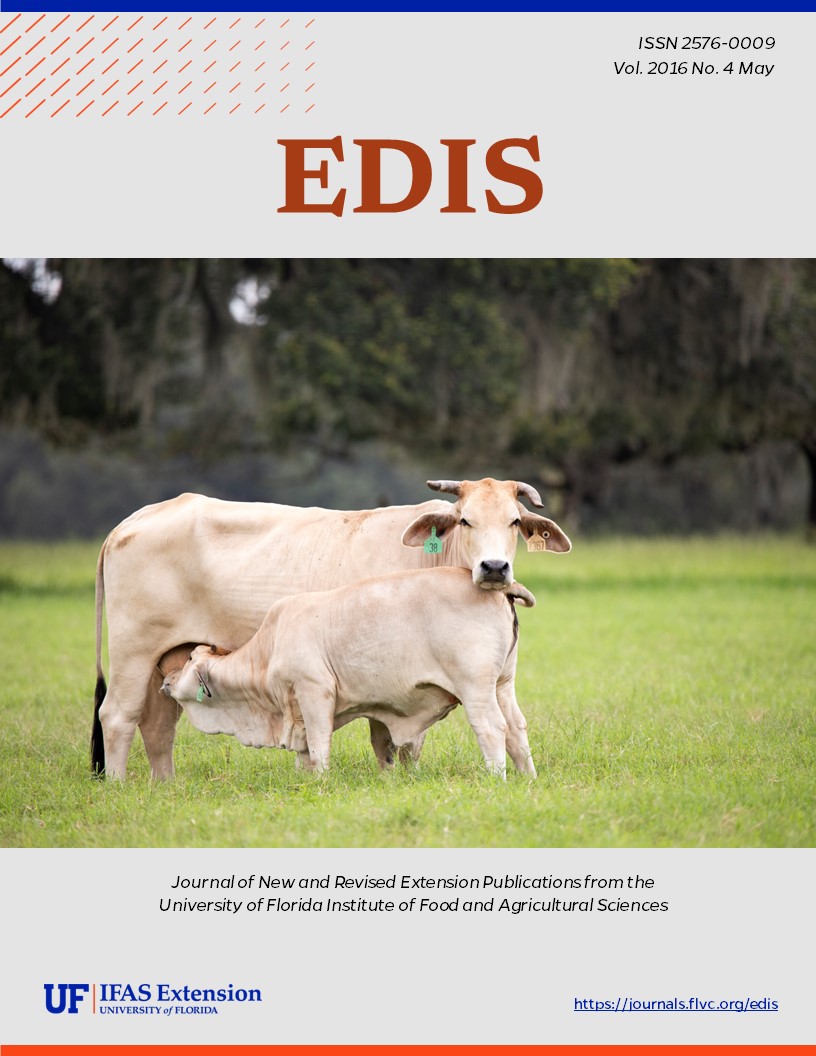Abstract
The viruses that cause hemorrhagic disease (HD) in deer do not cause illness in people, but they are a growing problem. HD is the most important viral disease of white-tailed deer in the United States. Large outbreaks have occurred in the northern Midwest and western United States. In Florida, outbreaks are fewer and less severe in populations of wild white-tailed deer than are outbreaks among wild deer in other areas of the United States, but farm-raised deer in the state are proving vulnerable to epizootic hemorrhagic disease virus: one of the viruses that cause HD.
This 6-page fact sheet describes best management techniques for outbreaks of HD in farm-raised deer. It includes strategies for best supportive care for sick animals, diagnostics, and integrated pest management to control biting midges that spread the viruses that cause HD, because the best way to manage HD is to prevent it. Written by Katherine A. Sayler, Charlotte Dow, and Samantha M. Wisely, and published by the Department of Wildlife Ecology and Conservation, May 2016.
References
Carpenter, S., P. S. Mellor, and S. J. Torr. 2008. "Control techniques for Culicoides biting midges and their application in the U.K. and northwestern Palaearctic." Medical and Veterinary Entomology. 22(3):175-87. https://doi.org/10.1111/j.1365-2915.2008.00743.x
Center of Food Security and Public Health. Iowa State University. Bluetongue factsheet. http://www.cfsph.iastate.edu/Factsheets/pdfs/bluetongue.pdf. Accessed 20 July 2015.
European Food Safety Authority. 2009. "Scientific opinion on epizootic hemorrhagic disease." EFSA Journal 7(12): 1418. http://www.efsa.europa.eu/sites/default/files/scientific_output/files/main_documents/1418.pdf Accessed 5 Decmber 2015. https://doi.org/10.2903/j.efsa.2009.1418
McVey, S. D. and J. N. MacLachlan. 2015. "Vaccines for prevention of bluetongue and epizootic hemorrhagic disease in livestock: A North American perspective." Vector-Borne and Zoonotic Diseases. 15(6):385-96. https://doi.org/10.1089/vbz.2014.1698
Mullens, B. A., A. C. Gerry, T. J. Lysyk, and E. T. Schmidtmann. 2004. "Environmental effects on vector competence and virogenesis of bluetongue virus in Culicoides: Interpreting laboratory data in the field." Veterinaria Italiana. 40:160-163.
OIE Terrestrial Handbook. 2014. "Epizootic haemorhhagic disease." http://www.oie.int/fileadmin/Home/fr/Health_standards/tahm/2.01.04b_EHD.pdf Accessed 20 June 2015.
Ostlund, Eileen. "Bluetongue virus (BTV) and epizootic hemorrhagic disease virus (EHDV) isolations/PCR positives." United States Animal Health Association Bluetongue and Related Orbivirus Committee Meeting October, 2015, Providence Rhode Island, USA.
Pfannenstiel, R. S., B. A. Mullens, M. G. Ruder, L. Zurek, L. W. Cohnstaedt, and D. Nayduch. 2015. "Management of North American Culicoides biting midges: current knowledge and research needs." Vector-Borne and Zoonotic Diseases. 15(6):374-84. https://doi.org/10.1089/vbz.2014.1705
Ruder, M. G., A. B. Allison, D. E. Stallknecht, D. G. Mead, S. M. McGraw, D. L. Carter, S. V. Kubiski, C. A. Batten, E. Klement, and E. W. Howerth. 2012. "Susceptibility of white-tailed deer (Odocoileus virginianus) to experimental infection with epizootic hemorrhagic disease virus serotype 7." Journal of Wildlife Diseases. 48(3):676-85. https://doi.org/10.7589/0090-3558-48.3.676
Ruder, M. G., T. J. Lysyk, D. E. Stallknecht, L. D. Foil, D. J. Johnson, C. C. Chase, D. A. Dargatz, and E. P. J. Gibbs. 2015. "Transmission and epidemiology of bluetongue and epizootic hemorrhagic disease in North America: current perspectives, research gaps, and future directions." Vector-borne and Zoonotic Diseases. 15(6): 348-363. https://doi.org/10.1089/vbz.2014.1703
Savini, G., A. Afonso, R. Mellor, I. Aradaib, H. Yadin, M. Sanaa, W. Wilson, F. Monaco, and M. Domingo. 2011. "Epizootic haemorrhagic disease." Research in Veterinary Medicine. 91(1):1-17. https://doi.org/10.1016/j.rvsc.2011.05.004
Stallknecht, D. E., A. B. Allison, A. W. Park, J. E. Phillips, V. H. Goekjian, V. F. Nettles, and J. R. Fischer. 2015. "Apparent increase of reported hemorrhagic disease in the midwestern and northeastern USA." Journal of Wildlife Diseases. 51(2):348-61. https://doi.org/10.7589/2013-12-330
United States Department of Agriculture: Foreign Animal Disease Preparedness & Response Plan. 2013a. Bluetongue Standard Operating Procedures. https://www.aphis.usda.gov/animal_health/emergency_management/downloads/sop/sop_btv_e-e.pdf Accessed 7 December 2015.
USDA. 2013. Orbiviruses, Bluetongue and Epizootic Hemmorhagic Disease: Gap Analysis Workshop Report. U.S. Department of Agriculture, Agricultural Research Service, Washington, DC. http://www.ars.usda.gov/SP2UserFiles/Program/103/OrbivirusGapAnalysisWorkshopFinalFeb2014.pdf . Accessed 4 December 2015.
Xu, B., M. Madden, D. E. Stallknecht, T. W. Hodler, and K. C. Parker. 2012. "Spatial-temporal model of haemorrhagic disease in white-tailed deer in the south-east USA, 1983-2000." The Veterinary Record. 170(11):288. https://doi.org/10.1136/vr.100000

